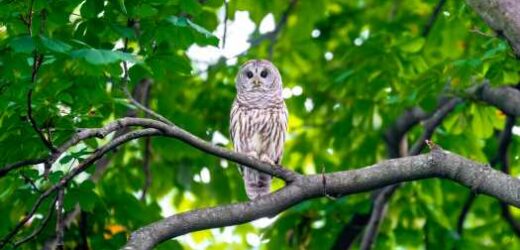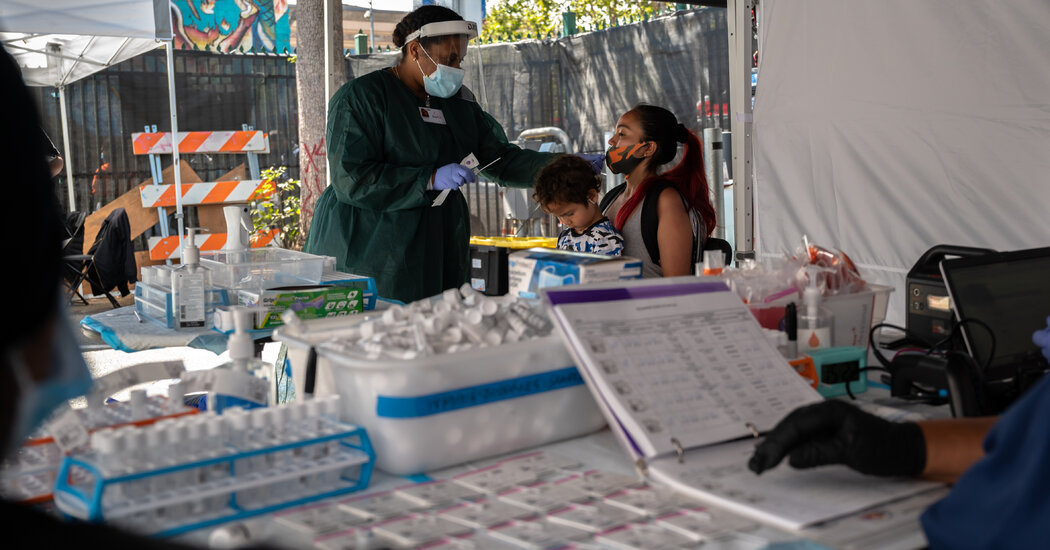She was a charismatic creature, as sassy and confident and constant as Harry Potter’s beloved Hedwig. As wise and playful a teacher as Merlin’s Archimedes. And in real life, an owl unusually accommodating of the many humans who gathered in Central Park every day to watch her snooze in her favorite hemlock tree or fly out through the Ramble on her nightly hunting rounds.
“We used to joke,” David Lei, a photographer, recalled, “that if there were a scientific formula for cuteness, Barry was it: fluffy and round, with those huge, expressive eyes. And I think she was very unusual — especially for a solitary bird — to be so generous with us, to let us observe her so closely every night.”
Barry the Barred Owl alighted in Central Park last October, and startlingly, remained here through the winter and spring and summer. Her arrival during the pandemic brought joy to many New Yorkers who had been hunkered down in their apartments, worried about Covid and their jobs and a crucial presidential election. She got people away from their Zoom meetings and TV screens, and out into the light and air of the park. She transformed folks who couldn’t tell a finch from a sparrow into ardent birders, spurred people who hadn’t picked up a camera since the days of dark rooms to take up digital photography, and turned children and grown-ups alike into students of all things owl, devouring books and videos about owl behavior, owl history and owl legends.
She brought strangers together in a community based on a shared love for this magical creature who’d made Central Park her unlikely home.
It’s a measure of just how many people Barry touched that her death last week in a collision with a Central Park Conservancy maintenance vehicle resulted in an outpouring of sorrow that was expressed around the world.
Early Monday evening, some 250 people gathered in Central Park for a vigil. Mourners festooned Barry’s beloved hemlock tree near the Boathouse and the fence around it with roses and sunflowers, and charming pencil drawings of owls. Children had left small Beanie Baby-like owlets there, and on the sidewalk, alongside a stunning chalk portrait of Barry, were scrawled heartfelt messages of love and farewell.
Pinned on the fence was a note from a child named Bella: “You were my friend and you made me happy. Because of you, I stopped being scared to go out during the pandemic.”
The vigil, organized by David Barrett, who runs the popular Twitter account Manhattan Bird Alert, was a kind of family reunion for Barry’s many fans, who did what they’d done for 10 months: trade favorite stories and photos of the owl’s adventures — the time she made a late night visit to the nearby American Museum of Natural History, the time she lay down on a branch on her stomach like a baby owl, the time she flew to the sailboat pond and gazed at her own lovely reflection in the water.
Some people recognized fellow Barry lovers only by sight or first names. Others had become friends who saw each other almost every day, trading text messages, in their own shorthand, about Barry’s whereabouts: she’s at “the Blair Witchy place,” she’s at “the hooting place,” she’s at “the raccoon place.”
“What amazes me the most is she welcomed us into her space,” said Stella Hamilton, a longtime birder who marveled at Barry’s willingness to engage with us directly and sometimes playfully, even allowing us to watch her do things like take an afternoon bath in Azalea Pond. “That moment when she looks into your eyes — that’s contact with your soul right there. She lets you know how she feels.”
According to Karla Bloem, the executive director of the International Owl Center, located in Houston, Minn., “owls are creatures of habit.” And so, Barry’s easy habituation to Central Park suggests she likely grew up in an urbanized environment. But like cats and dogs, she adds, owls “are very much individuals” with their own personalities, and Barry’s willingness to so openly display her emotions to us and to sleep and bathe in our presence (activities that could potentially make her vulnerable to predators) attested to her high comfort level with humans.
Every evening, an hour or so before dusk, a group of seven or eight Barry followers, including Ms. Hamilton and Mr. Lei, would gather in the Ramble to watch Barry’s pre-fly-out prep — preening her feathers, sharpening her talons and doing a few owl-y yoga stretches. Barry would then invite her humans, or so it seemed, to accompany her on the first segment of her nightly hunts: flying slowly from perch to perch with occasional pauses in between, as if eager not to let anyone fall behind. After 45 minutes or so, she would take off on her own, soaring off into the sky as her human friends headed home.
No one ever forgot that Barry was a wild creature, but I could not help but think of the relationship she developed with her humans as akin to what the fox in Antoine de Saint-Exupéry’s “The Little Prince” meant when he asked the little Prince to “tame” him — “tame” as in “to create ties,” to forge a friendship based on familiarity and routine.
As quarantine time made our lives feel baggy and shapeless, without offices to go to or appointments to keep, Barry’s followers came to regard their visits to her as bright punctuation points in the grayed-out Möbius strip of their daily lives. In a time of uncertainty, her presence became a source of continuity and comfort.
“She became our friend during a time when we couldn’t easily see friends,” said Meredith Pahoulis, a creative director and photographer. “It was a gift — she arrived at the perfect time. From freezing cold winter nights to hot summer nights, she was always there and I always knew where I could see her.”
Molly Eustis, a stage manager who found herself unemployed when theaters closed, affectionately described the owl as a little round “potato,” perched in a tree, with an impossibly cute “cinnamon roll face.” Seeing her for the first time in December was a magical moment: “This lone owl in the middle of the city in Central Park, in the snow, on the solstice, when I was feeling like a lone human after nearly a year of the pandemic, out of work, and not being able to travel to see my family for the holidays for the first time ever in my life.”
For me, Barry’s sudden death brought back memories of that sense of loss I felt as a child, reading all those sad animal books like “Charlotte’s Web,” “The Red Pony” and “Old Yeller,” and that many kids today feel reading about the sudden death of Hedwig in the last Harry Potter novel. If such books underscore the unforgiving cycle of life, Mr. Barrett observes that Barry’s death also reminds us that many “birds lead short lives.” An estimated “50 to 70 percent die in their first year. And even after that, bird mortality is high. But we generally don’t see them die,” he said. Rather, they “die in obscurity.”
Jenifer P. Borum, a writer and teacher who’d been sick with Covid, said following Barry through Central Park helped her to regain her strength. “Barry’s act of flying through our lives brought out the best in us,” she said. “We forged ties with her. Our group comprised people who might not have socialized otherwise.” The night of the vigil, it felt like that was “beginning to disperse and it made me sad.”
But the next owl, she hopes, will also bring the group and future owl watchers together.
“We will look for her in the next owl’s eyes. Though no owl will compare, ever.”
Michiko Kakutani is the author of the book “Ex Libris: 100+ Books to Read and Re-Read.” Follow her on Twitter: @michikokakutani and on Instagram: @michi_kakutani
Source: Read Full Article



